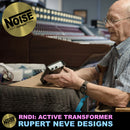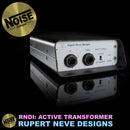
Description
Stunning tone & clarity for all of your instruments.
The RNDI’s signature sound is the product of new custom Rupert Neve-designed transformers and class-A biased, discrete FET amplifiers. The carefully orchestrated union of these two elements is key to the RNDI’s unique response, delivering a powerful and vibrant direct sound capable of reproducing the full harmonic depth of basses, guitars, acoustic instruments, and professional line level sources.
With portable, powerful, larger-than-life tone for your instrument and amplifier signals, the RNDI is truly the first standalone DI worthy of the Rupert Neve name.
“I didn’t know what I was missing until I plugged into the RNDI. ” - TOM BLANKENSHIP / MY MORNING JACKET
The Development
After coming into existence during an experimentation with new transformer designs, the RNDI was fine-tuned over a series of listening tests against the the most popular high-end DIs available. It was in these tests where the RNDI always seemed to add another dimension to the sound and bring the instruments to life. The lows felt richer, deeper and fuller, and the highs had outstanding clarity without any added harshness.
Most importantly, the design team noted:
“As musicians, the RNDI consistently stood out as the DI we wanted to play through.”


Active + Passive: The Best of Both Worlds
The RNDI’s signature sound is the product both of new custom Rupert Neve-designed transformers and class-A biased, discrete FET amplifiers. The carefully orchestrated union of these two elements is key to the RNDI’s unique response.
THE TRANSFORMERS
The custom transformers provide superior passive isolation while adding musical harmonics and dimension to the sound. The low impedance, transformer-balanced output excels at driving long cable runs, and performance is immensely consistent regardless of the connected equipment. This is very important for both live and studio environments where the unamplified signal may travel almost 100ft before hitting an amplifier. In other designs, these high-capacitance lines cause major reductions in high frequencies – not so with the RNDI.
THE CLASS-A, DISCRETE FET AMPLIFIERS
The class-A & discrete FET amplifier in the RNDI is powered by 48V phantom, and creates a very high impedance input of 2M Ohms that ensures consistent performance with a wide variety of instruments. The class-A design ensures that zero crossover distortion is added to the signal, which can add upper-order odd harmonics that are musically dissonant in nature. With the RNDI, the overwhelming majority of harmonic content is 2nd order (octave) with some 3rd order present (fifth above octave). These musically relevant harmonics, present in subtle amounts, actually add to the richness of the original signal. And the discrete aspect of the RNDI design means there are no ICs or digital components that can have negative effects on the tone.
Massive Headroom + Speaker Mode
In instrument mode, the RNDI’s high input headroom of +21.5dBU is capable of handling not only instruments, but professional, line level sources like interfaces and drum machines – without a pad. This allows the RNDI to serve as a way to “re-preamp” any previously recorded track using your interface and a desired pre-amp. To do this, simply connect a channel output of the interface to the input of the RNDI and connect the RNDI’s output to the preamp and engage 48V. By “re-preamping” you can apply the tone of another preamp to the source and more accurately automate or control the drive level on the preamp.
In speaker mode, the RNDI can handle the screaming output of a 1000-watt solid-state power amplifier (92 Vrms or 266Vp-p) to capture the full tone of the instrument, preamplifier, EQ, inserts, and the amplifier’s output stages before it hits the speakers. This technique allows the engineer to avoid any bleed in a live environment and any unwanted tone added by the speaker cabinet or microphone.
“The band wanted a more controlled guitar sound, so they switched to the Fractals…they were a little lacking in tonality, so I put RNDIs on all of them and everybody noticed the difference immediately. Any time I have to use a Fractal from now on, I’ll throw an RNDI on it. It just makes everything sound better.” – WILL MARKWELL / DEATH CAB FOR CUTIE

CONTROLS & I/O
¼” INPUT
Hi-Z unbalanced input:
2.2M Ohms (Instrument)
200 kOhms (Speaker)
¼” THRU
Parallel ¼” port used to send signal to an amp or speaker.
SPEAKER / INSTRUMENT INPUT LEVEL
Selects Speaker or Instrument level.
Max input: +21dBu Instrument, +41.5dBu Speaker
48V POWER LED
Indicates that +48V phantom power is present from the connected mic preamp (required to power the RNDI).
GROUND LIFT
Isolates the XLR Pin 1 from the instrument input ground.
OUTPUT
Transformer-balanced XLR output. Impedance less than 40 Ohms. Phantom power to the RNDI is supplied through this connection.
FEATURES
Groundbreaking Direct Tone
When class-A, discrete amplifiers meet Rupert’s custom transformers, good things happen to your tone. The RNDI is imbued with the unique components and design knowledge that makes it worthy of the Rupert Neve name.
Huge Headroom
The high input headroom of +21.5dBU is capable of handling professional, line level sources without a pad – and in speaker mode, the RNDI can handle the full output of a 1000-watt power amplifier (92 Vrms or 266Vp-p).
Rugged Solid Steel Frame
The rugged steel chassis features an industrial-grade powder coating, and is built to withstand the severe stresses of life on the road.
Takes All Kinds
The RNDI has immensely consistent performance across a wide variety of sources due to its 2M Ohm discrete FET input and high headroom. You can confidently use the RNDI with basses, guitars, acoustic instruments, keyboards, and even professional line level devices. In instrument mode, you can even connect a professional line level interface output to “Re-Preamp” a previously recorded source.
Drive Longer Lines
The low impedance transformer coupled output – below 50 ohms – is capable of driving long lines with unrivaled high frequency performance.
1/4″ THRU Output
In instrument mode the THRU output can feed the amplifier input for reinforcement. In speaker mode, the THRU is used to feed the amplified signal to the speaker.
Superb Phase Coherence
Phase coherence is excellent at all frequencies, which keeps the sound well-balanced and natural, and is especially vital when blending the direct signal with a microphone capture of the same source.
Ground Lift
A ground lift switch is provided on the back to help fix any problematic grounding.
Phantom Powered
The RNDI is powered by standard 48V phantom power. Power is indicated by a blue LED on the front panel.
Payment & Security
Your payment information is processed securely. We do not store credit card details nor have access to your credit card information.



























